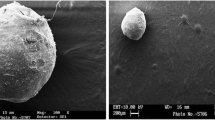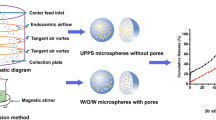Abstract
The degree of cross-linking of albumin microspheres, with and without drug, was assessed using turbidity measurements carried out in the presence of water and the protein denaturant guanidine hydrochloride (GuHCl) at a concentration that disrupted noncovalent bonds while having no effect on covalent bonds. The measurements allowed calculation of a turbidity ratio (T G/T W), expressed as the ratio of the turbidity of albumin microspheres in 6 M GuHCl (T G) divided by that in water (T w). A linear relation existed between T G/T W and the (i) temperature at which the microspheres were prepared, (ii) concentration of the cross-linking agent glutaraldehyde, and (iii) time of exposure to a second cross-linking agent, formaldehyde vapor, three conditions that increase the degree of cross-linking. The turbidity ratio also increased as the concentration of the albumin solution used to prepare the microspheres increased from 25 to 50%. Drug release from the microspheres consisted of an initial, rapid, burst followed by a second, slower, phase. The rates in both release phases were inversely related to the turbidity ratio, suggesting that this parameter has utility as an indicator of the degree of cross-linking in albumin microspheres.
Similar content being viewed by others
REFERENCES
A. Kramer. Albumin microspheres as vehicles for achieving specificity in drug delivery. J. Pharm. Sci. 63:1646–1647 (1974).
H. Ovadia, A. M. Carbone, and P. Y. Paterson. Albumin magnetic microspheres: A novel carrier for myelin basic protein. J Immunol. Methods. 53(1):109–122 (1982).
J. Kandzia, W. Scholz, M. J. D. Anderson, and W. Muller-Ruchholtz. Magnetic albumin/protein A immunomicrospheres. Preparation, antibody binding capacity and chemical stability. J. Immunol. Methods 75(1):31–41 (1982).
K. J. Widder, A. E. Senyei, and D. F. Ranney. Magnetically responsive microspheres and other carriers for the biophysical targeting of antitumor agents. Adv. Pharmaco. Chemother. 16:213–265 (1979).
T. K. Lee, T. D. Sokoloski, and G. P. Royer. Serum albumin beads: An injectable, biodegradable system for the sustained release of drugs. Science 213:233–235 (1981).
E. Tomlinson and J. J. Burger. Incorporation of water-soluble drugs in albumin microspheres. Methods Enzymol. 112:27–43 (1985).
R. R. Martodam, D. Y. Twumasi, I. E. Liener, J. C. Powers, N. Nishino, and G. Krejcarek. Albumin microspheres as carrier of an inhibitor of leukocyte elastase: Potential therapeutic agent for emphysema. Proc. Natl. Acad. Sci. 76(5):2128–2132 (1979).
E. Tomlinson. Microsphere delivery systems for drug targeting and controlled release. Int. J. Pharm. Tech. Prod. Mfr. 4(3):49–57 (1983).
R. S. Asquith and M. S. Ottenburn. Cystine-alkali reactions in relation to protein crosslinking. Adv. Exp. Med. Biol. 86:93–121 (1977).
A. H. Korn, S. H. Feairheller, and E. M. Filachione. Glutaraldehyde: Nature of the reagent. J. Mol. Biol. 65:525–529 (1972).
T. D. Sokoloski and G. P. Royer. Drug entrapment within native albumin beads. In S. S. Davis, L. Illum, J. G. McVie, and E. Tomlinson (eds.), Microspheres and Drug Therapy, Elsevier, Amsterdam, 1984, pp. 295–307.
K. Peters and F. M. Richards. Chemical crosslinking: Reagents and problems in studies of membrane structure. Annu. Rev. Biochem. 46:523–551 (1977).
I. Zolle, B. A. Rhodes, and H. N. Wagner, Jr. Preparation of metabolizable radioactive human serum albumin microspheres for studies of the circulation. Int. J. Appl. Radiat. Isotop. 21:155–167 (1970).
P. K. Gupta, C. Hung, and D. G. Perrier. Albumin microspheres. II. Effect of stabilization temperature on the release of adriamycin. Int. J. Pharm. 33:147–153 (1986).
J. J. Burger, E. Tomlinson, E. M. A. Mulder, and J. G. McVie. Albumin microspheres for intra-arterial tumor targeting. I. Pharmaceutical aspects. Int. J. Pharm. 23:333–344 (1985).
W. E. Longo and E. P. Goldberg. Hydrophilic albumin microspheres. Methods. Enzymol. 112:19–26 (1985).
J. B. Caldwell, S. J. Leach, and B. Milligan. Solubility as a criterion of cross-linking in wool. Textile Res. J. 36:1091–1095 (1966).
F. S. M. Van Kleef. Thermally induced protein gelation: Gelation and rheological characterization of highly concentrated ovalbumin and soybean protein gels. Biopolymers 25:31–59 (1986).
A. J. Aguiar, J. E. Zelmer, and A. W. Kinkel. Deaggregation behavior of a relatively insoluble substituted benzoic acid and its sodium salt. J. Pharm. Sci. 56:1243–1252 (1967).
D. J. A. Crommelin, N. Slaats, and L. van Bloois. Int. J. Pharm. 16:79–92 (1983).
M. T. Sheu, M. A. Moustafa, and T. D. Sokoloski. Entrapment of bioactive compounds within native albumin beads. II. Effects of rate and extent of crosslinking on microbead properties. J. Parenter. Sci. Technol. 40(6):253–258 (1986).
O. Pruksananonda, R. J. Kowalsky, and J. Swarbrick. Turbidity as an indicator of crosslinking in albumin microspheres. J. Pharm. Sci. 76:S292 (1987).
S. Lapanje. Physicochemical Aspects of Protein Denaturation, Wiley, New York, 1978.
A. Shrake, J. S. Finlayson, and P. D. Ross. Thermal stability of human serum albumin measured by differential scanning calorimetry I. Effect of caprylate and N-acetyltryptophanate. Vox. Sang. 47:7–18 (1984).
F. Franks. Protein conformational stability. 22nd Annual Educational Conference on Industrial Pharmacy, Arden House, Harriman, New York, February 8–13, 1987.
A. Yapel. Albumin medicament carrier system. U.S. Patent 4,147,767 (1979).
D. Hopwood. A comparison of the crosslinking abilities of glutaraldedhye, formaldehyde and α-hydroxyadipaldehyde with bovine serum albumin and casein. Histochemie 17:151–161 (1969).
K. J. Widder, A. E. SenYei, and D. G. Scarpelli. Magnetic microspsheres: A model system for site specific drug delivery in vivo. Proc. Soc. Exp. Biol. Med. 58:141–146 (1978).
E. Tomlinson, J. J. Burger, E. M. A. Schoonderwaerd, and J. G. McVie. Human serum albumin microspheres for intraarterial drug targeting of cytostatic compounds; Pharmaceutical aspects and release characteristics. In S. S. Davis, L. Illum, J. G. McVie, and E. Tomlinson (eds.), Microspheres and Drug Therapy, Elsevier, Amsterdam, 1984, pp. 75–89.
Author information
Authors and Affiliations
Rights and permissions
About this article
Cite this article
Rubino, O.P., Kowalsky, R. & Swarbrick, J. Albumin Microspheres as a Drug Delivery System: Relation Among Turbidity Ratio, Degree of Cross-linking, and Drug Release. Pharm Res 10, 1059–1065 (1993). https://doi.org/10.1023/A:1018979126326
Issue Date:
DOI: https://doi.org/10.1023/A:1018979126326




